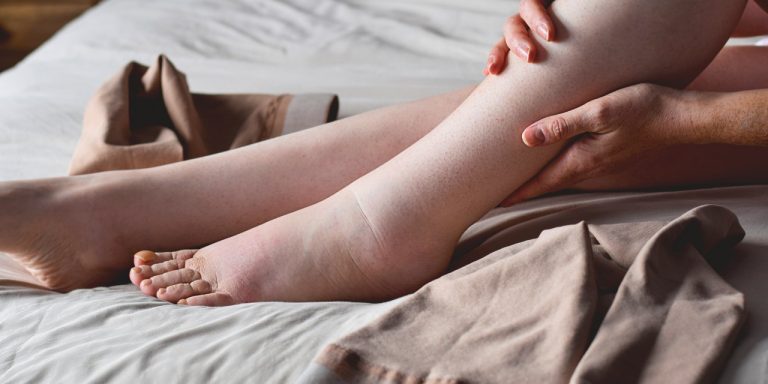
Swollen legs: what can you do about it?
What causes swollen legs and feet? Which home remedies and tablets help with water retention in the legs? Is water retention in the legs dangerous? Are there exercises for water retention in the legs? Learn how to reduce water retention in the legs.
What does water retention in the legs mean?
Water retention in the legs and swollen feet can be uncomfortable. Experts refer to this water retention in the tissues as oedema. This is particularly common in the summer months. However, heat is not the only reason for water retention in the legs and feet.
Recognising water retention in the legs
What does water retention in the legs feel like? Water retention in the legs brings on various symptoms. The following signs may indicate water retention in the legs and feet:
- The affected area is soft. If you press on the spot, a dent forms. This pressure test allows you to detect water retention in the legs quickly;
- The skin feels tight. Water in the feet and legs can sometimes cause pain. Occasionally, the areas may itch or tingle. They may also feel numb;
- Your trousers and shoes feel tighter than usual;
- With water retention in the feet, your ankles may appear less defined.
Important: If you experience shortness of breath and difficulty breathing alongside water retention in the legs, consult a doctor immediately. This could be an indication of a heart condition.
Why does water retention occur in the legs?
What causes water retention in the legs and feet? The swelling occurs because fluid leaks from the blood or lymphatic vessels and accumulates in the tissues. This can have various causes:
- Sitting or standing activities: if you sit or stand for long periods during the day, you may have swollen legs by the evening. This is because muscle movements in the legs help transport blood and lymphatic fluid from the legs to the heart. When you remain seated or standing for a long time, the muscles in your legs are inactive. As a result, fluids accumulate in the tissues of the legs and feet. This is also the reason for swollen feet and legs after a flight. Younger people are less affected by this symptom than middle-aged or older individuals;
- Heat: swollen feet and legs in summer are especially common. High temperatures cause blood vessels to dilate, allowing water to enter the surrounding tissues more easily. Due to gravity, water accumulates primarily in the feet and legs;
- Surgery: swollen legs often occur after surgery or injuries due to inflammatory processes. Inflammation, a common response to surgeries or injuries, causes the affected area to swell. The blood vessels dilate and become more permeable to fluid, which flushes out inflammatory agents. This is a natural process and the swelling usually resolves on its own.
Swollen legs: illness as a cause
In some cases, illnesses are the underlying cause of swollen feet and legs. Possible conditions include:
- Venous insufficiency: with venous insufficiency, the valves in the veins do not function properly. As a result, blood flows less effectively from the legs back to the heart, resulting in increased pressure in the leg veins. Fluid leaks out, accumulates in the tissues and causes swelling in the legs;
- Thrombosis: a sedentary lifestyle or venous insufficiency increases the risk of thrombosis. With thrombosis, blood clots (thrombi) form, disrupting blood flow and posing health risks. Blood clots are small clusters of platelets, red blood cells and proteins;
- Lymphoedema: with lymphoedema, lymphatic fluid does not drain properly, resulting in swelling in the legs, feet or arms;
- Kidney and liver diseases: with kidney disease, the body does not eliminate excess fluid effectively, causing water to accumulate in the tissues. Some liver diseases result in low levels of proteins in the blood, which bind water. When protein levels are too low, water accumulates more easily in the tissues;
- Heart failure: reduced heart function impairs blood circulation, causing it to pool in the legs. The pressure in the blood vessels in the legs increases and fluid leaks into the surrounding tissues. Heart failure then causes water retention in the legs. Heart failure can also affect kidney circulation, resulting in reduced fluid excretion and worsening swelling.
Note: swollen feet and legs often occur in older people. As the body ages, it becomes harder to transport blood from the legs back to the heart, potentially causing venous congestion and swelling.
Swollen legs and feet are common during pregnancy. But why is this? Hormonal changes make blood vessels more permeable, allowing fluid to enter the tissues more easily. Since the uterus grows and gains weight during pregnancy, the pressure on the pelvic vein also increases. This impairs the return of blood to the heart, potentially causing swelling in the legs and feet during pregnancy. If you are affected by high blood pressure, you are more likely to develop water retention in the legs during pregnancy.
In most cases, water retention in the legs is not dangerous for you or your baby. However, in some instances, the swelling may indicate an existing or developing condition. Speak with your obstetrician or gynaecologist. For example, if proteins are detected in your urine, this may suggest pre-eclampsia, a condition that causes high blood pressure and organ damage. Symptoms include rapid weight gain, nausea, vomiting and upper abdominal pain.
Water retention in the legs: when is it dangerous?
Is water retention in the legs dangerous? If water retention occurs infrequently, there is usually no need for concern. However, if swelling occurs often, consult your GP. Speak with a specialist if you notice varicose veins or spider veins.
If water retention is accompanied by chest pain, shortness of breath and a rapid heartbeat, immediate treatment is necessary. These are symptoms of a pulmonary embolism. In such cases, call an ambulance immediately.
What can be done about water retention in the legs?
There are several ways to reduce water retention in the legs. Here’s what you can do:
- Use a cream for water retention in the legs. These often contain cooling ingredients like horse chestnut or red vine leaf extract. Consult your pharmacist to check if these are suitable for you;
- When there is water in the legs, compression stockings support blood flow back to the heart and can prevent varicose veins. Your doctor can provide further information and prescribe these if necessary;
- Certain tablets may also help with water retention in the legs. Ingredients include horse chestnut extract, butcher’s broom or rutin. Ask your doctor whether these are suitable for you. If an underlying condition is identified, other medications for water retention in the legs may be required.
Lymphatic drainage for water retention in the legs stimulates lymphatic flow, helping to transport water build-up out of the tissues.
Important: lymphatic drainage is particularly effective when combined with compression therapy (compression stockings or bandages). Consult your therapist before lymphatic drainage about applying compression bandages after the treatment.
Swollen feet and legs: home remedies
Try various home remedies for water retention in the legs:
- Apple cider vinegar is considered a home remedy for swollen feet and legs. Add one teaspoon of apple cider vinegar to a glass of water and drink it slowly twice a day. Alternatively, soak a cloth in vinegar and apply it to the affected areas. This way, apple cider vinegar may help externally with water retention in the legs and feet;
- Schüssler salts may also help with water retention in the legs. Schüssler Salt No. 8 might regulate the body’s fluid balance;
- Cold wraps for the legs can provide relief from water build-up. Place a cloth in the freezer for a few minutes, then wrap it around the swollen area. Adding a small amount of apple cider vinegar to the cloth may enhance the effect;
- Drink diuretic teas, such as green tea or peppermint tea.
Tips for swollen legs
There are many practical tips to help relieve water retention:
- Incorporate exercise into your daily routine. Cycle regularly or go for walks. This activates the leg muscles and stimulates the venous and lymphatic systems. The blood then flows more easily from the legs back to the heart;
- Take regular movement breaks: when sitting or standing, the muscles in the legs are inactive. This hinders blood flow upwards and causes it to pool in the legs and feet. Therefore, avoid sitting or standing for long periods at a time;
- Ensure you’re eating a balanced diet and pay attention to your body weight: people with higher body weight are more prone to water retention in the legs; Reduce salt in your diet and avoid alcohol if possible. Also, drink plenty of water;
- Elevating your legs can also help reduce water retention. This is particularly helpful if you have limited mobility;
- Wear loose-fitting clothing. This improves blood flow;
- Take a cold foot bath. This is particularly effective for treating swollen feet caused by heat.
Exercises for water retention in the legs
Exercises for swollen legs and feet can help reduce swelling. These can easily be done at home:
- Lie flat on your back. Pull your toes upwards towards your head, then stretch them downwards. Repeat this exercise 30 times;
- Tense your gluteal muscles for a few seconds, then relax for a few seconds before tensing them again;
- Slowly rise onto your tiptoes. Hold this position for a few seconds, then lower back down onto your heels. Repeat this process several times;
- Lie on your back and raise your legs at a right angle. Simulate cycling motions in the air for about 30 seconds.
There are many ways to treat and prevent swollen feet and legs. Stay active and take care of your well-being. If you experience regular water retention in your legs and feet, consult your doctor.

The physiotherapist provided the editorial team with advice and input for this article. Stefan Wöll (graduate in physiotherapy) works for Helsana health consultation. He supports customers on questions to do with pain syndromes, sport and exercise.


Newsletter
Find out more about current health issues every month and get all the information you need about our attractive offers from all Helsana Group companies * delivered by e-mail to read whenever it suits you. Our newsletter is free of charge and you can sign up here:
We did not receive your information. Please try again later.
* The Helsana Group comprises Helsana Insurance Company Ltd, Helsana Supplementary Insurances Ltd and Helsana Accidents Ltd.